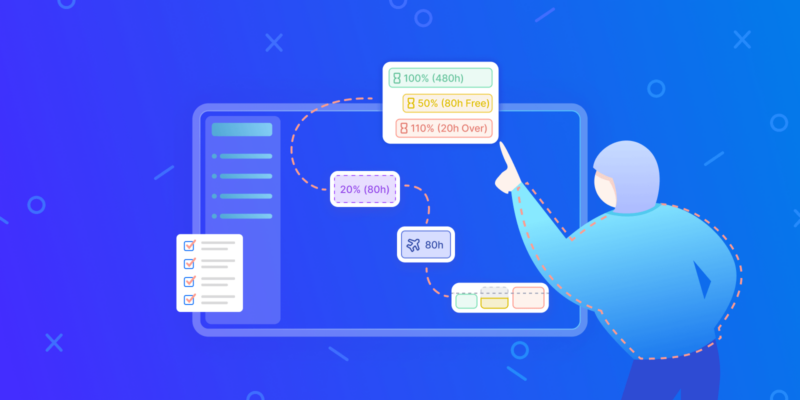Imagine if all tasks, big and small, in a project, were given the same significance in terms of importance and management. A project plan may consist of dozens, hundreds, or even thousands of tasks, and rendering them equally important would technically lead to micromanagement in its most absurd, extreme fashion.
It would become impossible to plan for any further steps, make necessary changes to projects if (or rather, when) needed, look at the big picture, or really, do anything that is mildly important when you are busy overseeing tiny steps in the ocean of tasks that are being performed by more than ten people.
The Importance of Milestones in Project Management
Milestones have a critical role in project management as they represent important points of progress or milestones within the project schedule. These are the stages that help track and manage the progress of the project. Milestones serve several important purposes:
Track Project Progress.
Project milestones provide markers to track project progress, which improves adherence to the project schedule and achievement of a defined goal.
Communication.
Project milestones serve as communication tools that allow the project manager, team members, and clients to understand the status of the project.
Risk Management.
Identifying and achieving milestones helps identify potential problems or delays early, which helps make decisions to reduce the risk of project delays.
Team Motivation.
Achieving milestones gives the project team a sense of accomplishment and increases morale and motivation.
Resource Planning.
Project milestones help you effectively allocate resources to plan and manage resources throughout the project life cycle.
To summarize, project milestones are important in project management because they offer a roadmap for progress, help in goal setting, promote risk management, increase team efficiency, and improve resource planning.
Project milestones can be effectively used to determine whether your project is going to be successful.
Also, milestones can serve as hints about how you should proceed with the project after a certain point in time and increase the chances of your project’s/future project’s success.

An easy way to explain project milestones
By definition, a project milestone is a task of zero duration that defines an important achievement in a project.
A milestone is a way to understand how the project is advancing when you are not familiar with all the tiny tasks being executed in the meantime. The zero duration shows that you technically don’t care how much time it took to achieve it since it symbolizes a specific achievement or an important point in time in a project.
However, this definition might not suit every project. Depending on what you planned for, what you need to achieve, and what are the key factors that determine project success, a milestone may represent any of those:
- Completion of a highly important task (or a group of tasks)
- Occurrence of an important event or decision
- Getting the project done by a specific “percent complete” for a given amount of work
- The production of a deliverable (or a number of those)
- Any unique, significant circumstance that takes place during your project’s lifecycle
Let’s look at an example that every person can relate to.
Imagine you are building a house. When you think about how many rooms you want to have, where the kitchen should be, or how many floors you need, you are technically in the planning phase.
After you are satisfied with your plan, you hire a team of workers who will proceed with implementation and execution (start building the house). Now your milestones can be anything that you consider important, or specific circumstances that might occur in the process.
For example, if you expect the foundation to be laid in a month, it’s a milestone, if you expect the roof to be completed in a few weeks, it’s another milestone, if you expect the kitchen to be finalized by the end of next month, it’s a millstone as well.
Notice how you don’t think about how exactly the roof will be constructed or how much time workers will spend on the construction. You don’t really understand anything related to construction and honestly, you don’t even care: all you need to know is when your milestones will be achieved to understand whether everything is going according to plan.
So the case looks like this: the house ready to be moved in is your end deliverable, you are the project manager and the workers are your team members.
Now the beautiful thing about milestones is that, unless something unexpected or unplanned happens (and it usually does by the way), you get to set them yourself. You decide whether the competition of the roof is important enough to be considered a milestone.
How do you know whether the roof is important enough to be considered a milestone though? That’s another story. To manage your project effectively via milestones, you will need to go through 3 phases: Define your milestones, use milestones to manage the project, and use them as a reporting tool for future projects.
Defining project milestones
The keys to understanding whether a specific task should be a milestone are impact, significance, and meaning. For example, if you are doing a website redesign, every single page cannot be a milestone, but a number of pages that, more or less, show the overall picture of the future redesign can be a milestone.
To define your milestones correctly, here are some helpful questions:
- How significant is this task in terms of project execution?
- What is the impact of this task or event, if it meets/doesn’t meet the deadline?
- Can the completion of this task showcase project success/tell me that the project is doing fine?
It’s important to note that your job is not done with creating initial milestones. Since the project lifecycle is most likely subject to change (meaning that something in your plan or strategy might be changed) milestones should be changed accordingly.
Also, there is just no way that you will be able to meet all preliminary set milestones: some of them will be missed, some might be eliminated, others might lose their importance due to changes, and new milestones will be required.
Finally, milestones are extremely project-specific, even if you are doing the same type of project (two website redesigns for example). Each project has different stakeholders, different clients with different views, and different deliverables in terms of significance. Make sure you approach each project separately, or you may risk project failure.
Using milestones to manage the project
Once the planning phase is over and milestones are set, the work commences. From here on, you should be monitoring the milestone completion and making sure that everything is going according to plan.
The key to successful milestone management, as always, is team communication. You have to make it clear to your team that they must communicate everything concerning milestone achievement so that you can be ready in case something goes wrong.
For example, if you know that a milestone will not be met in advance, you will have time to think about how to minimize the negative impact, set a new milestone, or try to understand why the milestone was delayed.
Using milestones as a reporting tool for future planning
After you are done with your project (regardless of how well you handled it) the records of milestone activity can be examined to understand what was going on during the whole time, what went wrong, what you could have done differently, or why some milestones failed to be met.
Here are some questions that will help you make a more precise analysis:
- Where are your designed milestones important for the project?
- How many milestones have been met?
- Which of them played the most important role?
- How did the achieved milestones impact project success?
- How many milestones were missed and why?
- What impact did those missed milestones have?
- What did you do to counter the negative impact of the missed milestones and how effective your decisions proved to be?
Milestones are a super effective way to manage multiple projects at the same time effectively, especially if you are not a fan of micromanagement (which is pretty damn good!). Use the data gathered after each project and analyze it to make future project planning and management even more effective. This is how you will be able to constantly achieve project success.
Follow us


